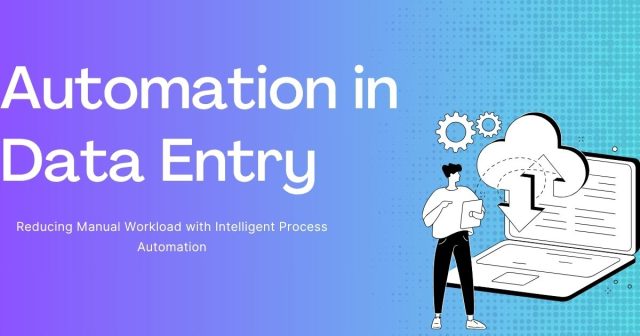For decades, business has been running on data entry. Businesses in every sector need access to precise data in order to remain competitive, drive decision making, keep tabs on progress and nurture long-term relationships with customers. But as businesses grow and their data explodes, manual processes for entering data are less and less viable.
The solution lies in automation in data entry—disrupting the way organizations are dealing with information. In this article we’ll look at the problems of manual data entry, the solutions that technology-driven automation is making possible, and pragmatic ways you can incorporate some of these solutions into your business. If you like the article “Data Management 101,” you’ll learn real-world examples and emerging trends that may cause you to rethink your approach to handling data.
The Unseen Costs of Traditional Data Entry
High Error Rates Impacting Your Business Operations
Mistakes made by man are part of manual data entry. Research has proved that manual data entry comes with an error rate of 1-5% – sounds little but it?s disaster at scale. A small error, such as a misplaced decimal point in financial data or a wrong address for a customer, can lead to chaos across your business systems.
These errors lead to:
-
Incorrect inventory counts
-
Failed customer deliveries
-
Compliance violations
-
Damaged customer relationships
-
Financial discrepancies
Time-Intensive Processes
Transferring information by hand costs a lot of human labor. Average data entry clerks allow for such rounds the clock focus and subsequently to give the results 10,000 to 15,000 keystrokes per hour. For companies that process thousands of documents each day, this equates to weeks or months of work that could be doing something more valuable.
Scalability Limitations
Manual data entry is very labor intensive as you scale your business. Hiring new staff increases overhead, costs valuable training time, and adds a greater potential for error. “Many businesses get in this trap of where the more growth they have, the more data processing they need, and they aren’t doing a very efficient job of that.
Understanding Automation in Data Entry
Data entry automation involves using technology to capture, manipulate, and enter data without human involvement. This blend leverages multiple advanced technologies to provide a smooth data flow between them.

Optical Character Recognition (OCR)
OCR software allows you to recognize and get content from various types of files, such as scanned documents, PDF files, or images into searchable and editable data. Current OCR systems can even read handwritten text, a multitude of fonts, and scanned documents with high accuracies that are above 99%.
Robotic Process Automation (RPA)
RPA is the generation of software robots that emulate human activities in digital systems. These bots can also sign into applications, click on screens, pull tips, and input data across many systems. Robotic process automation is very good at repetitive, rules-based process steps that can be forecasted.
Artificial Intelligence and Machine Learning
By applying AI, the automation is getting smarter with the usage of intelligence for processing data. Machine learning algorithms can:
-
Recognize patterns in unstructured data
-
Validate information against business rules
-
Adapt learning from corrections to become more accurate over time
-
Catch exceptions that linear automation can overlook
Natural Language Processing (NLP)
NLP powers systems that can comprehend and interpret human language, which is accomplished by extracting useful meaning from emails, agreements, applications and other documents laden with text.
The Advantages of Automating Data Entry are Plenty
Dramatic Accuracy Improvements
Mechanised systems can be reliably above 95% and many surpass 99% confidence. Unlike humans, an automated system never gets tired, never gets distracted, and never makes transcription errors. This predictability is especially beneficial for compliance-bound industries, which require accuracy in data.
Substantial Cost Reductions
Automation does have some front end costs, but it will save you money in the long run. Companies often see:
-
Data pro-cessing cost reduced to 60-80%
-
Elimination of overtime expenses
-
Shortened QA reviews are needed (all are acceptable).
-
Lower error correction costs
Increased Processing Speed
Machines can work round the clock with no downtime for data processing. Jobs that would take human workers days or weeks to complete are done in hours. This quick speed of time-to-market, means companies are more able to respond quickly to changing markets and customer demand.
Enhanced Employee Satisfaction
It frees employees from repetitive data entry, so they can concentrate on strategic, creative, or analytical work. This kind of change tends to result in greater job satisfaction, lower attrition and more effective use of human potential.
Improved Compliance and Auditability
Robotic platforms generate comprehensive logs of all data processing operations, which results in simple and accurate compliance reporting. This level of transparency is especially important to industries with high regulation.
Data Entry Automation Implementation – A Strategic Approach
Assess Current Processes
Start with a visualization of current data entry workflows. Identify:
-
Volume and nature of documents dealt with
-
Current processing times and costs
-
Error rates and correction procedures
-
Integration requirements with existing systems
-
Compliance and security requirements
Choose the Right Technology Stack
Not all automation technologies are created equal:
-
OCR solutions are better suited for well-formed forms and documents
-
RPA platforms are appropriate with repetitive tasks on a range of applications
-
There are AI-driven tools for complex unstructured data
Most frequently, hybrid approaches are the ones that yield the most complete picture.
Start with Pilot Projects
Begin with smaller, more focused projects for automation. This approach allows you to:
-
Pilot test tech at your actual job site
-
Train staff on new systems
-
Refine processes before full-scale implementation
-
Demonstrate ROI to stakeholders
Plan for Integration
Make sure your automation integrate seamlessly with your current business systems. Consider:
-
API availability and compatibility
-
Data format requirements
-
Security protocols
-
Backup and recovery procedures
Invest in Change Management
I would never succeed in implementing automation if the employees dont own it. Deliver extensive training, explain benefits explicitly, and reassure employees about job security by emphasizing how automation will augment, not replace, human skills.
Real-World Success Stories
Financial Services Transformation
A medium sized insurer had automated their claims processing operation which had formally been reliant on the manual capture of data from claim forms, medical notes and correspondence. They combined the power of OCR and artificial intelligence (AI) in document analysis, thus slashing processing times from 3-5 days to 4-6 hours while increasing accuracy from 92 percent to 99.2 percent.
Healthcare Administrative Efficiency
There was a health care entity that ‘automated’ patient registration and insurance verification. The system now collects data from insurance cards, driver’s licenses and forms through mobile OCR. This cut the waiting list waiting time for a patient by a 40% and created more time for nursing staff to deal with patients and not paper.
Manufacturing Supply Chain Optimization
A manufacturer automated vendor invoice handling, which surfaced thousands of invoices each month. Their RPA implementation now automates 95% of invoices, cutting processing costs by 70% and speeding up vendor payments.
Automating the Data Entry of the Future
Intelligent Document Processing
Newer systems integrate multiple AI technologies to comprehend context of a document, not just to extract text. It can make meaning, validate data across business rules and process complex documents which earlier needed human judgment.
No-Code Automation Platforms
It’s easier than ever for non-tech savvy users to adopt automation through intuitive platforms. With this solution, the business analyst or the process owner can develop automation workflows without the need to understand extensive programming and thus bring automation to the masses in an enterprise.
Cloud-Native Solutions
The use of a cloud-based automation platform enables faster scaling, lowering infrastructure expenses, and simplifying the integration with general-purpose cloud services. These offerings can dynamically scale processing on demand and extend availability globally.
Advanced Analytics Integration
The automation systems of the future will deliver much better insights into data patterns, processing efficiency and business trends. This insight can be used by companies to become better run, and make data-informed decisions more easily.
Strategically Transitioning to an Automated Approach
Implementing automated data entry is not just about a technological upgrade, it is an operational advantage that can reshape how your operations work. The savings are not only in cost but the better accuracy, quicker processing and happier employee.
The success lies in its thoughtful use. When in doubt, consider the processes you use today, decide on technology, plan for incremental roll-out and change management. Your organization that adopts automation today would be able to gain substantial competitive advantages here as the volumes of data are increasing and the tolerances are tightening.
Start your automation experience by piloting a project in a clear area of your business. Humane 4ee This method enables you to show return on investment early, while you build the skill and confidence to pursue the more holistic application. The future is to the companies that know how to treat information in the right way – automation of data entry is your way to the future.
For service-focused companies looking to optimize online visibility, explore our guide to SEM strategies tailored for lead generation.










